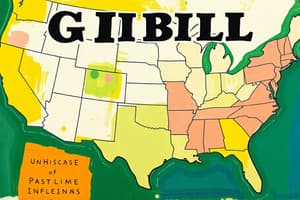Podcast
Questions and Answers
What was the main purpose of the Servicemen's Readjustment Act of 1944?
What was the main purpose of the Servicemen's Readjustment Act of 1944?
- To provide benefits to World War I veterans
- To facilitate suburbanization in urban centers
- To construct the Interstate Highway System
- To offer education and training opportunities to World War II veterans (correct)
What was a major consequence of the suburbanization movement in the post-war era?
What was a major consequence of the suburbanization movement in the post-war era?
- A decrease in housing markets and the construction industry
- An increase in urban population density
- An expansion of housing markets, the construction industry, and the overall economy (correct)
- A decline in economic growth
What was authorized by the Federal-Aid Highway Act of 1956?
What was authorized by the Federal-Aid Highway Act of 1956?
- The creation of the GI Bill
- The construction of the Interstate Highway System (correct)
- The construction of public housing projects
- The development of urban infrastructure
How did the GI Bill contribute to suburbanization?
How did the GI Bill contribute to suburbanization?
What was a significant consequence of the construction of the Interstate Highway System?
What was a significant consequence of the construction of the Interstate Highway System?
What was a major factor in the post-war American economic growth?
What was a major factor in the post-war American economic growth?
What was the main impact of suburbanization on the economy?
What was the main impact of suburbanization on the economy?
What was a key benefit provided by the GI Bill to World War II veterans?
What was a key benefit provided by the GI Bill to World War II veterans?
What was the general sentiment of Americans during the 1950s?
What was the general sentiment of Americans during the 1950s?
What was a lasting legacy of the 1950s economic boom?
What was a lasting legacy of the 1950s economic boom?
What was the purpose of promoting consumerism during the Cold War era?
What was the purpose of promoting consumerism during the Cold War era?
What was the impact of the GI Bill on American society?
What was the impact of the GI Bill on American society?
What characterized the post-World War II era?
What characterized the post-World War II era?
What was the relationship between consumer culture and the American way of life?
What was the relationship between consumer culture and the American way of life?
What was the impact of suburbanization on American society?
What was the impact of suburbanization on American society?
What was the driving force behind the prosperity and optimism of the 1950s?
What was the driving force behind the prosperity and optimism of the 1950s?
What is the current influence of the 1950s economic boom on American society?
What is the current influence of the 1950s economic boom on American society?
What was one of the benefits of the expansion of the interstate highway network in the United States?
What was one of the benefits of the expansion of the interstate highway network in the United States?
What contributed to the surge in mass consumption in the 1950s?
What contributed to the surge in mass consumption in the 1950s?
Approximately how many babies were born in the United States during the Baby Boom?
Approximately how many babies were born in the United States during the Baby Boom?
What was a key role that women played during the 1950s?
What was a key role that women played during the 1950s?
What was one of the impacts of the Baby Boom, suburbanization, and women's expanding roles in the 1950s?
What was one of the impacts of the Baby Boom, suburbanization, and women's expanding roles in the 1950s?
What was a result of the technological advances of the 1950s?
What was a result of the technological advances of the 1950s?
What fueled the rise of mass consumer culture in the 1950s?
What fueled the rise of mass consumer culture in the 1950s?
What was a characteristic of the 1950s economic growth?
What was a characteristic of the 1950s economic growth?
Flashcards are hidden until you start studying
Study Notes
The GI Bill and Its Impact
- The GI Bill, also known as the Servicemen's Readjustment Act of 1944, provided benefits to World War II veterans, including education and training opportunities, low-cost mortgages, and unemployment benefits.
- The GI Bill played a significant role in shaping the post-war American society and economy.
Suburbanization and Interstate Construction
- The post-war era saw a massive suburbanization movement, with returning soldiers seeking affordable housing outside of urban centers.
- The Federal-Aid Highway Act of 1956 authorized the construction of the Interstate Highway System, facilitating suburban expansion and economic growth.
- Suburban development and interstate construction transformed the American landscape and fueled the economy.
Impact of the GI Bill on Suburbanization
- The GI Bill provided veterans with access to low-cost mortgages for home purchases, fueling suburbanization.
- Many returning soldiers took advantage of the GI Bill's benefits to buy homes in newly developed suburban communities.
Interstate Highways and Economic Growth
- The construction of the Interstate Highway System improved transportation infrastructure, promoting commerce, tourism, and trade across the country.
- The expansion of the interstate highway network created jobs, boosted industries such as construction and automobile manufacturing, and enhanced mobility for Americans.
Economic Boom and Mass Consumption
- The economic boom of the 1950s contributed to a surge in mass consumption, with Americans having increased disposable income and access to a wide range of consumer goods.
- The culture of mass consumption became a defining feature of the era, shaping lifestyles and values in post-war America.
Baby Boom and Demographic Shift
- The Baby Boom was a significant increase in birth rates following World War II, resulting in approximately 76 million babies being born in the United States between 1946 and 1964.
- This demographic shift had a profound impact on American society, influencing education, consumer trends, and family dynamics.
Women's Expanding Roles in the 1950s
- Women began challenging traditional gender roles and expanding their roles beyond the home, contributing to the economic growth of the post-war era.
- The rise of the feminist movement saw women advocating for equal rights and opportunities in the workplace and society.
Family Dynamics and Consumer Culture
- The combination of the Baby Boom, suburbanization, and women's expanding roles had a profound impact on family dynamics, with families moving away from extended family networks and relying more on nuclear family structures.
- The emphasis on consumerism influenced family life, with material possessions becoming symbols of success and status.
Technological Advances and Consumer Culture
- The 1950s saw significant technological advances, including television, home appliances, and automobiles, which became more affordable and accessible.
- These advancements improved living standards and influenced consumer behavior and popular culture.
Mass Consumer Culture and Economic Growth
- The 1950s witnessed the rise of mass consumer culture, fueled by the availability of consumer goods and increased purchasing power.
- Advertising and marketing played a pivotal role in promoting consumption and shaping consumer preferences.
1950s Economic Growth and Legacy
- The 1950s marked a period of unprecedented economic prosperity in the United States, characterized by high employment rates and rising wages.
- The economic growth of the 1950s had a profound social and cultural impact, shaping family dynamics, leisure activities, and community life.
- The legacy of the 1950s economic boom continues to influence the economy, infrastructure, and consumer culture of the United States today.
Studying That Suits You
Use AI to generate personalized quizzes and flashcards to suit your learning preferences.




